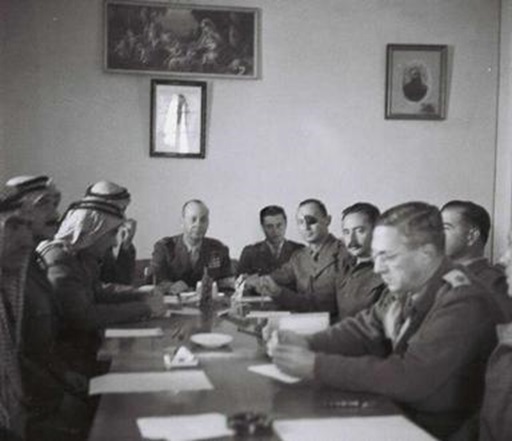
April 3, 1949
Israel’s War of Independence ended with the signing of armistice agreements between the newly established Jewish state and four Arab states in 1949. Separate agreements were signed with Egypt (February 24), Lebanon (March 23), Jordan (April 3) and Syria (July 20). However, peace treaties were not signed between Israel and its Arab neighbors or with the Palestinian Arabs. No international borders were fixed or recognized between Arab states and Israel. The Armistice with Jordan was the result of several months of negotiations and meetings. The photo shows a meeting between Moshe Dayan and Jordanian Colonel Abdullah El Tal in Jerusalem in December 1948.
As a result of the War, the city of Jerusalem was divided into Arab and Jewish sectors, not to be reunited until after the June 1967 War. The West Bank of the Jordan River was a spoil of war for Jordan’s Emir Abdullah. He and his long-term successor, King Hussein, controlled it outright or had active influence over it until 1988.
Mediated negotiations had begun in March in Rhodes under the auspices of United Nations Chief Negotiator Ralph Bunche (see https://israeled.org/ralph-bunche-born/). Israel wanted to ensure that any agreement would allow Jews to have access to holy places, that Iraqi troops would be removed from the West Bank and the swap of territory in the Arab populated region called the Little Triangle near Haifa.
Later on April 24, 1949, Jordan, as part of its “Greater Syria Plan,” annexed the lands of the West Bank in a move regarded by most of the world, including the Arab League, as an illegal annexation. The West Bank and East Jerusalem remained under Jordanian control until Israel acquired them during the Six Day War in June 1967. For the next 20 years, Jordan sought the return of these lands, finally relinquishing that objective in July 1988 when the country renounced all legal and administrative ties to the West Bank and East Jerusalem, essentially opening the way for the Palestinians to negotiate instead for use of the West Bank.
To read the complete Armistice Agreement: http://avalon.law.yale.edu/20th_century/arm03.asp
